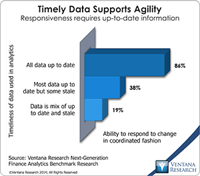With Ventana Research’s 2024 Digital Business Market Agenda, we continue the guidance we have offered for two decades to help enterprises derive maximum value from digital business technology investments. Through our market research and expertise, we identify trends and best practices and share insights on how to achieve technological effectiveness, particularly in key processes and systems to engage the workforce.
Read More
Topics:
Performance Management,
Digital Business,
Digital Communications,
Work Management,
Experience Management,
Sustainability & ESG,
Generative AI,
Digital Applications,
Digital Operations,
Digital Intelligence
With Ventana Research’s 2023 Market Agenda, we continue the guidance we’ve offered for two decades to help organizations derive maximum value from digital business technology investments. Through our market research and expertise, we identify trends and best practices and share insights on how to achieve technological effectiveness, particularly in key processes and systems to engage the workforce.
Read More
Topics:
Performance Management,
Business Continuity,
Digital transformation,
Digital Business,
Digital Security,
Digital Communications,
Work Management,
Experience Management,
Governance & Risk,
Sustainability & ESG
With the announcement of Ventana Research’s 2022 Market Agenda, our expertise in Digital Business continues to advance the market need for effective investments into technology, and I will outline here the key areas of focus to provide insights to organizations that can increase their organizational resilience and workforce readiness. We are proud to provide expertise on ensuring technological effectiveness through our market research and experience in providing guidance on trends and best...
Read More
Topics:
Performance Management,
Business Continuity,
Governance, Risk & Compliance (GRC),
Digital transformation,
Digital Business,
Digital Security,
Digital Communications,
Sustainability Management,
Work Management,
Experience Management
Digital transformation of the Office of Finance has been a recurring theme for several years, but adoption accelerated when offices were locked down and organizations had to collaborate remotely. It involves shifting manual work, often completed via spreadsheets circulating in emails, to software and systems for improved performance.
Read More
Topics:
Performance Management,
Office of Finance,
Digital transformation,
Digital Business,
digital finance
Strategic planning has always been difficult. But it is even more so in this age of rapid digital transformation and the pressure of business continuity, which has introduced disruptive changes. What’s needed, ironically, is a methodical approach to how an organization manages strategic planning to allow for beneficial disruption that is not avoidable, balancing finance and operations, engaging existing expertise and factoring in technology to ensure that new initiatives can be strategically...
Read More
Topics:
Performance Management,
Business Continuity,
Digital transformation,
Digital Business,
Digital Security,
Digital Communications,
Experience Management
Subscription pricing models are no longer new. Many companies have experience with this pricing model even if there has not been complete adoption across their entire product and service offerings. Companies that use this model, or have spent time looking at the approach, understand the approach of a recurring revenue stream based on a repeating flat fee.
Read More
Topics:
Performance Management,
Sales,
Customer Experience,
Marketing,
Office of Finance,
Financial Performance Management,
Price and Revenue Management,
Digital Commerce,
Predictive Planning,
Subscription Management
With the announcement of Ventana Research market agenda, a new expertise in Digital Business has been launched, I will outline the areas of focus that provide insights to organizations that can be used to optimize technology, increase agility and organizational readiness. We are proud to provide expertise on digital effectiveness through our research and insights on trends and best practices.
Read More
Topics:
Performance Management,
Governance,
Business Continuity,
Risk,
Digital transformation,
Digital Business,
Digital Security,
Digital Communications,
Sustainability Management,
Work Management,
Experience Management
Ventana Research defines financial performance management (FPM) as the process of addressing often overlapping issues involving people, process, information and technology that affect how well finance organizations operate and support the activities of the rest of their organization. FPM software supports and automates the full cycle of finance department activities, which include planning and budgeting, analysis, assessment and review, closing and consolidation, internal financial reporting...
Read More
Topics:
Performance Management,
ERP,
FP&A,
Human Capital Management,
Office of Finance,
Consolidation,
Financial Performance Management,
FPM
The annual Oracle OpenWorld user group meeting provides an opportunity to step back and take a longer view of business, industry and technology trends affecting the company. Last year, after listening to Larry Ellison’s and Mark Hurd’s vision for the future of IT, I wrote that Oracle had to continue shifting its focus to business applications because the accelerating shift to cloud computing would lead corporations to outsource their IT infrastructures, services and security to third parties....
Read More
Topics:
Big Data,
Performance Management,
SaaS,
ERP,
Office of Finance,
Analytics,
Cloud Computing,
PaaS,
Digital Technology
The ERP market is set to undergo a significant transformation over the next five years. At the heart of this transformation is the decade-long evolution of a set of technologies that are enabling a major shift in the design of ERP systems – the most significant change since the introduction of client/server systems in the 1990s. Some ERP software vendors increasingly are utilizing in-memory computing, mobility, in-context collaboration and user interface design to differentiate their...
Read More
Topics:
Performance Management,
ERP,
FP&A,
Human Capital,
Office of Finance,
Reporting,
Consolidation,
Reconciliation,
Analytics,
Business Analytics,
Business Performance,
Financial Performance,
Uncategorized,
Financial Performance Management,
FPM



















